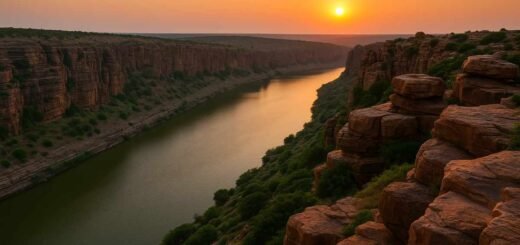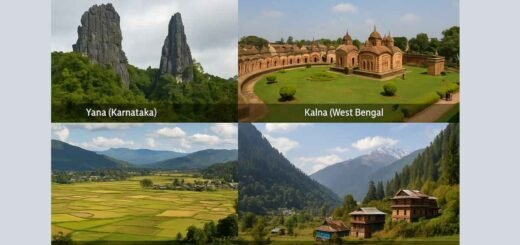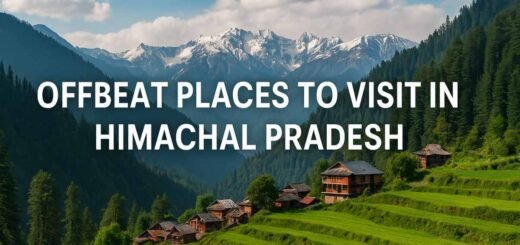Unexplored Destinations India: 8 Hidden-Gems That Will Ignite Your Wanderlust
Unexplored destinations India – discover 8 off-beat travel gems in India waiting to be explored. Plan your next adventure today!
unexplored destinations India are more than just off-beat spots — they’re windows into untouched nature, local culture and serene escapes. If you’re looking to step away from the crowds and experience a deeper, quieter side of India, this guide will introduce you to eight lesser-known places that deserve a spot on your travel list.
Contents
- 1 Quick Facts at a Glance
- 2 1. Why Choose Unexplored Destinations India
- 3 2. The Hidden Gems
- 4 3. How to Reach
- 5 4. Best Time to Visit
- 6 5. Best Things to Do
- 7 6. Local Cuisine & Food to Try
- 8 7. Where to Stay
- 9 8. Shopping & Souvenirs
- 10 9. Seasonal Travel Insights
- 11 10. Nearby Attractions
- 12 11. Travel Tips
- 13 12. FAQs
Quick Facts at a Glance
- Number of destinations featured: 8
- Travel style: Off-beat, less touristy, immersive in nature & culture
- Recommended season: Varies by region (see “Best Time to Visit” for each)
- Access: Some remote places; plan transport & stay ahead
- Highlights: Nature, culture, tranquillity, authenticity
1. Why Choose Unexplored Destinations India
Venturing into unexplored destinations India means:
- Immersive experiences in nature away from tourist crowds
- Authentic cultural interaction with local communities
- A chance for sustainable, responsible travel to places not over-commercialised
2. The Hidden Gems
2.1 Ziro Valley, Arunachal Pradesh
- Located in Arunachal Pradesh, home to the Apatani tribe and known for its lush green hills and traditional architecture.
- Activities: village walks, exploring paddy-fields, witnessing tribal culture.
- Tip: Respect local customs; accommodation can be basic in remote villages.
2.2 Mawlynnong, Meghalaya
- Called “Asia’s cleanest village”, nestled amidst Meghalaya’s hills and forests.
- Activities: explore living root bridges, village trails, waterfalls.
- Tip: Limited infrastructure – stay in guest-houses, travel light.
2.3 Gandikota, Andhra Pradesh
- A dramatic gorge known as the “Grand Canyon of India”, located in Andhra Pradesh.
- Activities: fort exploration, riverside camping, sunset views.
- Tip: Nearest major town is reachable; ideal as a weekend escape if you’re based in south India.
2.4 Kakkathuruth, Kerala
- Tiny island in Kerala’s Alappuzha district, gift-wrapped in backwaters and sunset vistas.
- Activities: backwater rides, birdwatching, sunset photography.
- Tip: Go early morning for stillness; weather can change quickly near water.
2.5 Doold‑pathri (Doodhpathri), Jammu & Kashmir
- High-altitude alpine valley in the Pir Panjal range, famed for milky streams and meadows.
- Activities: meadow strolls, nature photography, easy treks.
- Tip: Cold weather expected; plan transport carefully as remote.
2.6 Nighoj, Maharashtra
- Village famous for natural river-potholes in the Kukadi river, geological wonder in Maharashtra.
- Activities: trek along riverbed, cultural village visits.
- Tip: Water levels vary; check local conditions if planning river walk.
2.7 Badami & Pattadakal Circuit, Karnataka
- Historic region in Karnataka: rock-cut cave temples at Badami, Chalukya architecture at Pattadakal.
- Activities: temple tours, heritage walks, landscape photography.
- Tip: Guided tour helps decode intricate carvings; stay in nearby town since amenities limited.
2.8 Velas Turtle Beach, Maharashtra
- Quiet village on Konkan coast, known for olive-ridley turtle nesting and slow-paced beach time.
- Activities: witness turtle hatchings, beach walks, village homestays.
- Tip: Visit during turtle-season (usually Nov–Mar); limited tourist infrastructure.
3. How to Reach
- Use regional airports or major train stations as hubs (e.g., for Ziro, Mawlynnong, Doodhpathri).
- Local transport may involve taxis, buses or shared jeeps into remote areas.
- For remote locations: carry basic supplies (snacks, water, first aid) as amenities may be minimal.
- Check for seasonal road closures especially in hilly or Himalayan regions.
4. Best Time to Visit
- Ziro Valley: March-October for greenery, cultural festivals.
- Mawlynnong: Best in dry season (October-May) when the village is accessible.
- Gandikota: Winter (October-February) for comfortable weather and clear skies.
- Kakkathuruth: Winter morning for mist and calm backwaters.
- Doodhpathri: Late spring to early summer (May–June); avoid heavy snow seasons unless well-equipped.
- Nighoj: Post-monsoon when river-potholes visible (September–November).
- Badami / Pattadakal: October–March for pleasant weather.
- Velas: Turtle-nesting season November–March.
5. Best Things to Do
- Engage with local communities — learn traditions, crafts, village life.
- Nature walks, off-beaten paths, sunrise/sunset photography.
- Stay in simple guest-houses or homestays to maximise authenticity.
- Try local cuisine — regional dishes, local produce.
- Pack responsibly — minimal single-use plastics, support local economy.
6. Local Cuisine & Food to Try
- In Arunachal (Ziro): Try traditional Apatani dishes made with local produce.
- Meghalaya (Mawlynnong): Khasi cuisine — enjoy local greens, smoked meats, rice.
- Andhra (Gandikota): Konkan/Andhra coastal cuisine – fresh fish, kokum-based curries.
- Kerala (Kakkathuruth): Backwater fish, coconut-based dishes, toddy (if permitted).
- Jammu & Kashmir (Doodhpathri nearby): Alpine valley fare — simple dhabas, soups.
- Maharashtra (Nighoj/Velas): Konkan cuisine – coconut, fish, kokum; turtle-beach village snacks.
- Karnataka (Badami/Pattadakal): North Karnataka cuisine – jowar roti, spicy gravies, local sweets.
7. Where to Stay
- Opt for home-stays or guest-houses in villages to support local economy.
- Book early for remote places where availability is limited.
- For locations with minimal infrastructure, carry backup essentials (power bank, torch, basic first-aid).
- In hilly/mountain areas: check for WiFi/phone connectivity if you need it.
8. Shopping & Souvenirs
- Ziro: Tribal handicrafts, Apatani fabrics.
- Mawlynnong: Khasi hand-woven items, local herbals.
- Gandikota: Photos/prints of the gorge, local crafts.
- Kakkathuruth: Coconut-based handicrafts, local art.
- Badami & Pattadakal: Stone-craft replicas of temple carvings, Chalukya style souvenirs.
- Velas: Local fish and sea-produce delicacies (where legal), village craft.
- Tip: Always ask for fair-trade price and respect local customs when shopping.
9. Seasonal Travel Insights
- Monsoon & Post-Monsoon: Great for green landscapes (Mawlynnong, Kakkathuruth, Nighoj), but check for road/bridge closures.
- Winter: Good for dry weather beaches (Velas), heritage sites (Badami), alpine valleys (Ziro).
- Summer: High-altitude areas may still be accessible but expect chilly nights (Doodhpathri).
- Avoid peak tourist season at popular spots — these hidden gems benefit from fewer crowds.
10. Nearby Attractions
- Near Ziro: Visit tribal villages, forest trails.
- Near Mawlynnong: Dawki river, Living Root Bridges area.
- Near Gandikoto: Harihara and Belum Caves, local temples.
- Near Kakkathuruth: Explore broader Kerala backwaters around Alappuzha.
- Near Doodhpathri: Visit Srinagar or Gulmarg for contrast.
- Near Nighoj: Explore the Ahmednagar district, other village geology.
- Near Badami/Pattadakal: Aihole, Hampi (for day-trip extensions).
- Near Velas: Konkan coast coast-line drives, Karwar, Gokarna.
11. Travel Tips
- Always check local travel advisories, weather, and road conditions.
- Be respectful of local culture — ask permission before photography in tribal areas.
- Carry a little cash — some remote places may not have digital payment or ATMs.
- Pack layers — remote, high altitude or coastal places may see big temperature shifts at night.
- Use environmentally-friendly practices — avoid plastic waste, support local green initiatives.
- Stay flexible — infrastructure may be basic; adapt to local pace.
12. FAQs
Q1: What makes unexplored destinations India worth visiting compared to mainstream spots?
A1: unexplored destinations India offer quieter, more authentic travel experiences — nature, culture, less crowd.
Q2: Are these hidden-gem locations safe for solo travellers?
A2: Many are safe, but solo travellers should take standard precautions: inform someone of your itinerary, carry local contact, stay in known accommodation, especially in remote places.
Q3: How do I pick which unexplored destination India to visit from the list?
A3: Choose based on region (north/south), travel time, season and your interests (nature, culture, heritage).
Q4: Is infrastructure an issue in these unexplored destinations India?
A4: Yes — some places may have limited accommodations, transport or connectivity. Plan ahead and adjust expectations.
Q5: What about costs? Are these destinations expensive?
A5: Often they are more affordable than mainstream spots, especially if you stay in local guest-houses and use local transport; however remote transport may cost more.
Q6: Are these destinations suitable for families with children?
A6: Many are family-friendly if you plan carefully (accommodation, transport, medical access). But remote treks or high-altitude spots may not suit very young children.
unexplored destinations India hold the promise of journeys that feel personal, soulful and untouched by mass tourism. Whether you’re drawn to tribal valleys, backwater islands, historic forts or heritage temples — there’s a hidden gem waiting. Pack your bags, choose your destination from this list, and embark on a travel experience that goes beyond the usual. Explore these unexplored destinations India, and let the adventure begin!


